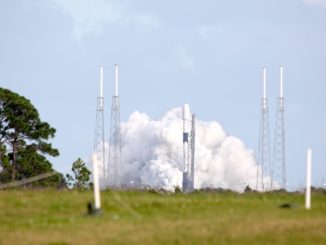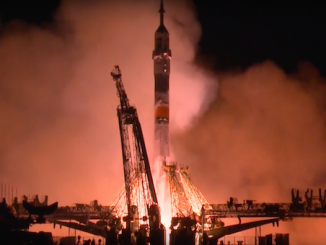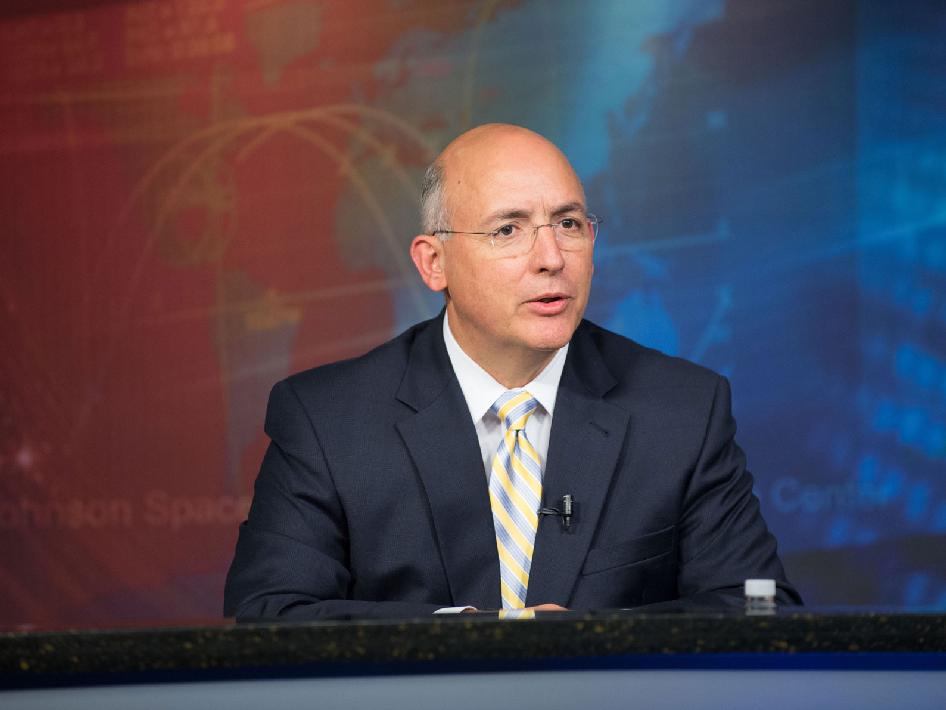
Mike Suffredini is leaving NASA after 10 years at the helm of the International Space Station program, overseeing assembly of the largest spacecraft ever built and shepherding the program through numerous political and technical roadblocks.
He took over as space station program manager at NASA’s Johnson Space Center in Houston in August 2005, and his last day at NASA is Sept. 9. Kirk Shireman, deputy director of JSC, takes over as program manager after Suffredini’s exit.
Suffredini oversaw a flurry of space shuttle assembly flights to finish construction of the complex after the Columbia accident, a period with an unprecedented pace of spacewalks and engineering challenges that many insiders say rivaled the Apollo moon missions, at least in technical complexity.
After the last space shuttle mission in 2011, the space station entered a new phase focused on research into how the human body responds to spaceflight, new life support systems that future missions into deep space will use, and new manufacturing techniques in orbit.
Scientists working on new treatments for Salmonella food poisoning and Duchenne muscular dystrophy use the space station to develop potential vaccines, and the research lab received its first 3D printer last year, a unit that could help astronauts build their own spare parts instead of relying on a supply line from Earth.
NASA’s focus now is to utilize the station as a testbed for the agency’s plans to send astronauts beyond Earth orbit. Besides serving as a pathfinder for future expeditions to lunar orbit — a region known as cis-lunar space — and eventually Mars, the station is opening up space to new commercial tenants.
Suffredini says he hopes the International Space Station can prove there is a market for a commercial platform in low Earth orbit after its retirement. His next job is to study just that for SGT Inc., a consulting and engineering services firm based in suburban Washington, D.C.
SGT plans to set up a commercial space division, which Suffredini will head from Houston.
At the top of the list for scariest moments in Suffredini’s tenure: A spacewalk in 2013 in which astronaut Luca Parmitano’s helmet filled with water, obstructing his vision and hearing and forcing a rush back to the airlock.
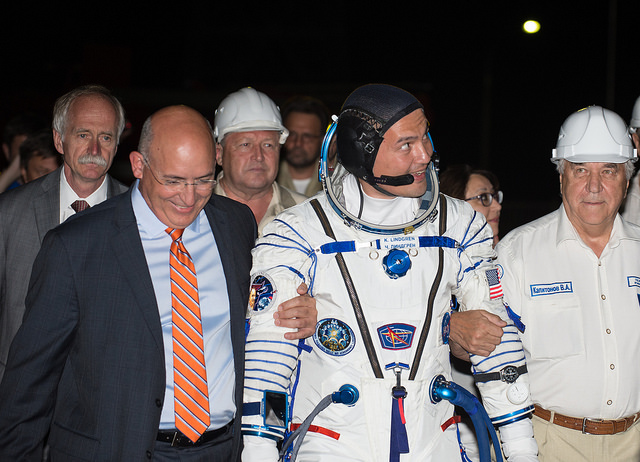
With a price tag of more than $100 billion, the space station is the product of a 15-nation partnership that solidified in 1994 with an agreement for Russia to participate in the ambitious engineering project. Russia’s inclusion was part of a post-Cold War thawing of relations between Washington and Moscow, and it helped solve the space station’s budget woes.
The first piece of the outpost launched from Kazakhstan in 1998, and the station has been permanently occupied since November 2000. It now flies 250 miles up, having hosted 220 people from 17 countries.
Now the station faces new hurdles in its logistics pipeline after a series of three failures of uncrewed resupply missions conducted by Orbital ATK, Russia and SpaceX, the lab’s three primary cargo providers.
NASA is working with Boeing and SpaceX to develop commercially-operated crew transport craft, but the commercial crew program’s goal to begin operations in 2017 appears in jeopardy, mainly due to budget concerns. The uncertainty has forced the U.S. government to renegotiate an agreement with Russia to accommodate NASA astronauts on Soyuz capsules a year longer than hoped.
Then comes the space station’s end-of-life plan, when mission control will evacuate the complex and drive it to a destructive re-entry over the remote South Pacific.
The U.S. government, Russia and Canada have agreed to continue space station operations through 2024, and decisions from the European Space Agency and Japan are due soon. But it may take longer to finish work on the station required to support NASA’s deep space exploration plans, and few are convinced a commercial orbiting lab will be flying to take over by the mid-2020s.
Before becoming program manager, Suffredini was deputy manager of the space station and led the program’s operations, vehicle development and business management divisions. He also worked in the space shuttle program after joining NASA in 1989, and holds a bachelor’s degree in aerospace engineering from the University of Texas at Austin.
Suffredini chatted with Spaceflight Now in his final weeks as NASA’s head of the space station partnership, sharing his memories, vision for the commercialization of low Earth orbit, and the status of the program in its 17th year of flight.
Q: Can you update me on how research is doing aboard ISS? Did the SpaceX failure affect it at all?
A: “Our plan with SpaceX-7 was not a flight with a heavy focus on research, but yes, of course, we lost research. But we had so much already on-board that we could keep working. We always keep a backlog. There’s a version of our consumables chart that also talks about utilization now. We sort of track and keep a certain backlog of utilization on-board.
“A lot is going on, particularly with the one-year crew, in human research. So we have quite a bit of supplies to do the human research part. With the backlog and the focus of research being primarily human research right now with the crew, that’s one of the higher level efforts going on on-orbit. We’ve managed to keep the crew busy.
“We’re averaging something like 39 hours per week right now. In the next increment, we’re shooting for a minimum for research. I think we’ll do better than that, but between now and the end of the year, we’re looking at a bit of a lull in research based on what was lost on SpaceX-7. We’ll probably also do some EVAs (spacewalks). On HTV, we have some research to keep the crew busy, then we have some EVAs, so by the time we get to Orb-4 in December, then we’ll have a big rush of research. When that arrives, it would be nice to have some of this other work done, so we’re going to try to do a mandatory minimum, even though we’ll be busy after we’re done, and probably be down about two, three or four hours per week between now and the end of the year. We’ll also do some EVAs in order to get that work behind us, so when we start catching back up with research, we’ll have more crew time to dedicate to it.
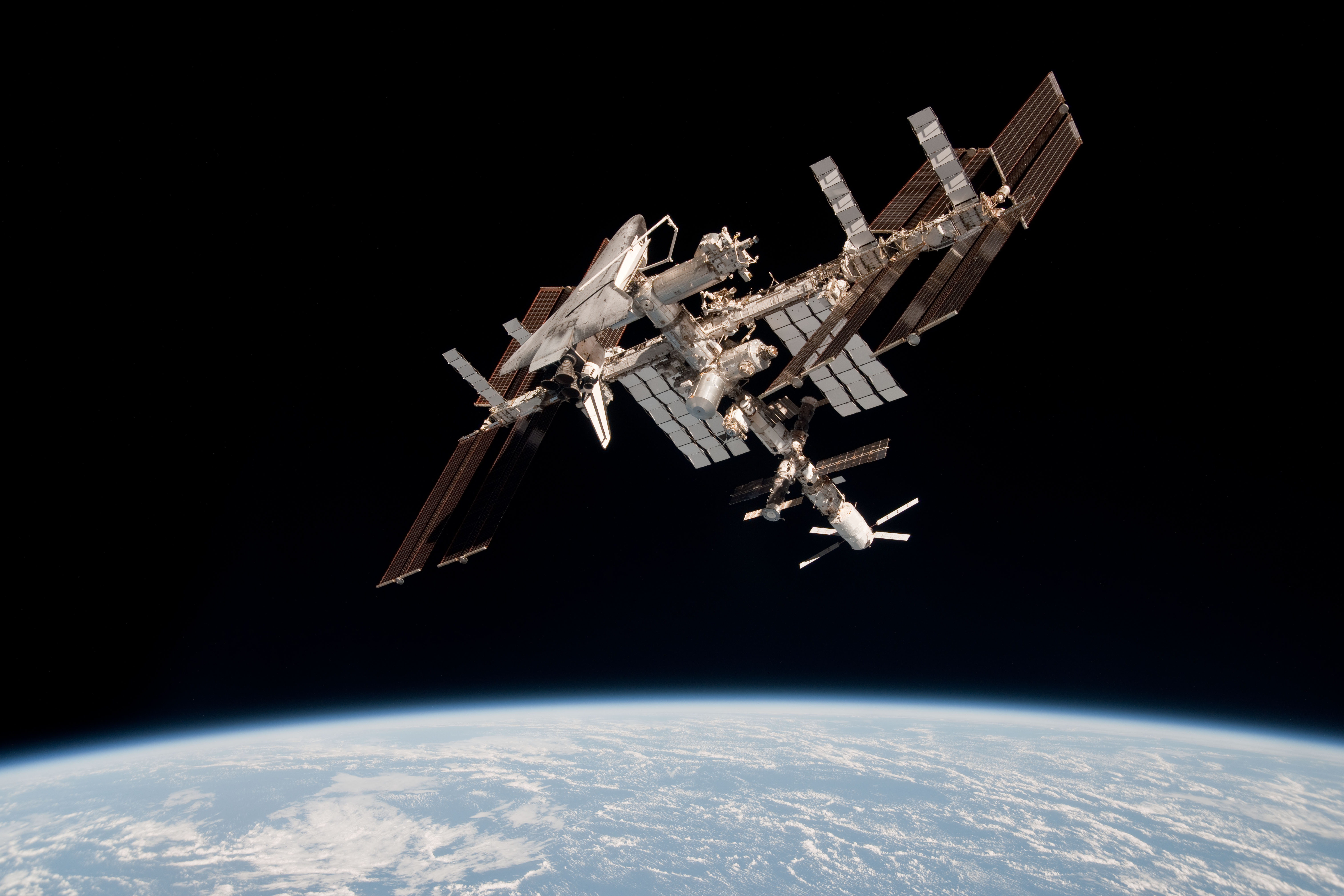
Q: You’ve spent a decade at the helm of the space station program, and I want to get your reflections on the achievements and challenges you’ve faced in that time. What stands out to you?
A: “If you think of challenges, I think about them in a couple of bites in terms of immediate issues. We’ve had two or three big orbit challenges that I’ve dealt with as program manager. Of course, we had the Luca (Parmitano) incident. That was pretty critical in terms of risking life. We had the solar array tear and the subsequent repair. That was pretty significant. We had the SARJ (Solar Alpha Rotary Joint) problem. We sorted that out and haven’t talked about it much since then, but that was a big deal for us in terms of trying to figure out how to recover from that.
“Earlier in my career, before I was program manager, we also lost all three control MDMs (during the STS-100 shuttle flight in 2001). That was a pretty harrowing moment, when we still had the pallet attached that had the SSRMS (robot arm) on it, and the Russians had launched and didn’t have loiter capability, so they needed to come dock, and here we are with all three computers lost and no way to get the pallet off and get the shuttle on its way. That was pretty exciting.
“From that aspect, we’ve had a number of moments in our lives building and operating ISS that were challenging, but of course, the team did a fantastic job. I’ve told folks my job was just to remain calm and keep everyone pointed in the right direction. All the real work was done by the men and women that operate and maintain the ISS. They’re just a fantastic group of folks.
“The challenging areas for us have been the transition from having the shuttle to not having the shuttle. The work we had to do, not only to really negotiate how many shuttles were going to be left in the program, but also to work within the partnership because of that impact, and trying to get everybody until the end and figure out how to successfully physically transition because when the shuttle was done, we expected some slips before the commercial (cargo) vehicles showed up. But they slipped more than we thought, and in the end, it turned out all of our pre-positioning (of logistics) really helped us get through that, so it didn’t look like a big deal on the outside. But that was a big challenge, transitioning away from the shuttle onto commercial cargo. That was one of the biggest challenges we dealt with because of the political challenges, the technical, the international partner implications and challenges, and trying to to sort through that. That was a big moment for us as a program.
“Another one was when we transitioned ourselves. We really needed to change our mindset from assembly to utilization. That took some figuring out, but we figured out how to do it. That’s how we operate today. The team that really worried about how do we assemble ISS, all of those same teams now focus on how do we make utilization as efficient as we can, as opposed to having one organization worry about utilization and another organization worry about how to build and operate the station. We’ve evolved away from that now that everybody is focusing on how to operate and sustain the vehicle in order to do research as efficiently as we can. To me, that was a big transition for us.”

Q: What do you see as the major challenges over the next few years for the space station program?
A: “Getting back on solid ground with regard to logistics. That’s going to be a big challenge for us. We don’t have a lot of margin in the systems right now, so getting those vehicles flown and getting ourselves back in a more robust posture, that’s a challenge for us.
“I think it’ll be a big challenge to transition to commercial crew, not a challenge like we shouldn’t do it, it’s something we need to do, but it’ll be interesting to transition from the mindset where somebody else does all the search and rescue and the crew training and all that, to now we need to transition to commercial crew. We not only have to fly the crew, we have to recover the crew and also, perhaps most challenging, is how do you transition from Soyuz to commercial crew when you don’t exactly know when commercial crew is going to be there. That’s a big challenge for us.
“The other one is to put ourselves in a posture to clearly focus on growing the research, particularly the research into commercialization of low Earth orbit. We truly need to focus on that. We need to figure out how to make it as efficient as we can so more and more customers can utilize ISS, and then someday somebody can create a business case based on real data that says if I build a low Earth orbit platform, I can make money, and at that point we’ll have somebody build a platform that will replace ISS.
“That’s critical for the growth of the economy in low Earth orbit, and also to relieve NASA of that responsibility so they can move on and explore beyond low Earth orbit. We really need to build the case so that we can keep a low Earth orbit capability, so NASA, and perhaps the partner countries, can focus on going beyond low Earth orbit.
Q: The partners are starting to get on-board with extending the ISS lifetime to 2024, but how long do you think it can fly based on structural analyses? Also, how long do you think it should fly to capture all the data required to be able to press on into deep space?
A: “We’ve done the work to tell us 2028 is OK structurally. I would tell you based on how we got to 2028, and the margins I saw in the system, that you could probably go at least another four years on top of 2028. At some point, you get diminishing returns, but because we have so much of the hardware made to be replaced on orbit, and if you use a process that keeps you efficient with regard to how you build spares and repair spares, I think you could remain relatively cost-effective. I think you could go another four years on top of 2028, but that’s just me wagging a number in front of you.
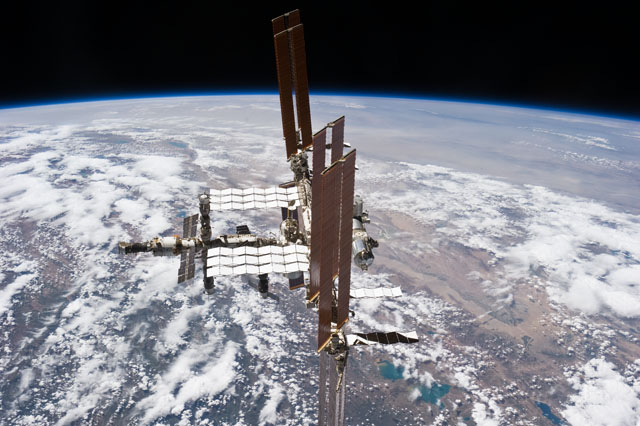
“Really, the answer to your other question has got to be driven by two factors. Station can go away when there’s a commercial capability that’s available such that we can complete the work we need to do in low Earth orbit to support exploration. Some people are not quite you’re ever going to complete your work in low Earth orbit because there’s a lot of critical systems you want to test close to home in a microgravity environment before you decide you want to go to Mars or even cis-lunar space. I’m not sure you can ever wean yourself from a low Earth orbit capability, but if NASA got to the point where they thought they had their systems all tested, then the other reason ISS can go away is because governments don’t have to stay in low Earth orbit. There’s two factors: Either there will be another platform to take over from ISS, or governments decide they don’t need it anymore, and they can go and explore without it.
“I foresee we’ll find you may never get to the point where you don’t want some capability in low Earth orbit, but we certainly may get to the point where we don’t want to pay for that anymore as a government. That’s why one of the most critical things for us going forward is to continue to become as efficient as we can doing research on-board and be getting potential commercial providers to the ISS inexpensively so they figure out what is going to make money and what won’t make money in low Earth orbit, so that somebody someday can sit down and show a business case to show you can make a profit from a low Earth orbit platform.
“That’s really critical going forward — that NASA be given what it needs to get as many potential commercial providers to ISS to see what will work and won’t work in research, and even in manufacturing.”
Q: I know it’s not politically tenable in the current climate, but the Chinese may have a space station in the 2020s. That’s several (presidential) administrations away, so things could change.
A: “Absolutely. That’s a possibility. You don’t know what they’re building a station to do, so you don’t know capabilities they might have. The Russians have said also that they’re interested in having a government platform. If you can build a commercial platform though, that governments can use and feel good about utilizing, then that would save them that money and allow them to buy time on a commercial platform. The objective, of course, is to have enough capability in low Earth orbit so that could be an option for many governments, so they can focus their investment on beyond low Earth orbit, and just utilize a capability in low Earth orbit for all the things they’ll need to test out for things like that.”
Q: How important is it to not have another gap between the end of ISS and missions to cis-lunar space or Mars?
A: “I think it’s critically important. I think if we stop flying humans into space that we may be stuck. There would be a longer row to hoe to get going again. Much longer, I think. It’s vitally important to keep the momentum we have going. The commercial piece will be a big part of this. When you grow commercial, then space becomes a market for everybody, not just NASA and other governments. Then it becomes more of a conversation, not an if. It’s like, ‘Hey, we’re in low Earth orbit, halfway to anywhere in space.’ It becomes more part of a conversation of when we’re going to go beyond. I don’t think we will be there if we let station go away before we’re ready to go do human flights to cis-lunar space.”
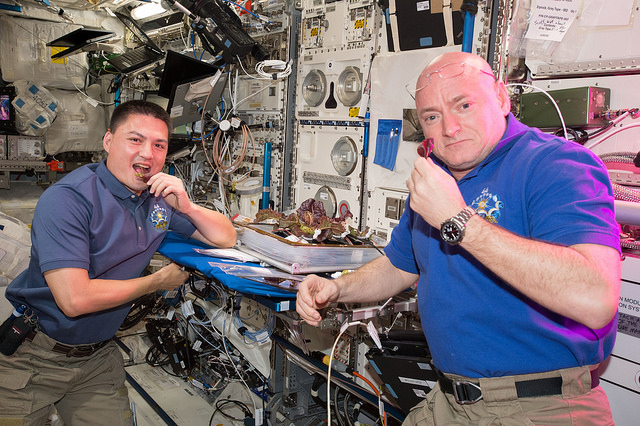
Q: I would like to get your thoughts on the space station’s place in space history. Looking back decades from now, what will have been the role of ISS in the development of space?
A: “Our thoughts on what the space station would do have evolved. I view the space station as what allows us to explore beyond low Earth orbit. Without it, we wouldn’t be able to do that. The other big legacy of ISS will be the economy in low Earth orbit. It will be what allows us to build an economy such that businesses have, no kidding, a use for a laboratory in Earth orbit that is commercially viable. To me, those two things are what will be the legacy of ISS.”
Q: What are your future plans, and when is your last day at NASA?
A: “My last official day at NASA is Sept. 9. That’s when I check out. This will be my last week (Aug. 17-21) of sitting at the head of the table. Next week, I’ll be there with Kirk (Shireman), and Kirk will be doing all the standard meetings. I’ll be there to answer questions and the like, then I go to represent the program at the Soyuz launch, and then I come home and my last day is Sept. 9.
“On the 14th (of September), I begin work as an employee of SGT working directly for Kam Ghaffarian as his Vice President for Commercial Space, which is a new division being created when I get there. It’s a new division to go look at private and public partnerships, and investigating the idea of building a commercial low Earth orbit platform.”
Q: So it’s directly building off of what you just mentioned, the commercialization of low Earth orbit?
A: “Like I told Kam when he talked to me, I said, ‘I dont know how to do anything except build and operate a space station, so I don’t know what else I can do to help out.’ We thought it would be good to build this divison, which will look at a lot of aspects of commercial use of low Earth orbit and investigate different types of partnerships. Part of it also is to go do a study to figure out what sort of platform would be viable, and if we can go off and see if we can put something together to build that.”
Q: NASA just signed a contract modification with Russia for Soyuz crew launches in 2018 and landings into early 2019. Were you surprised that was necessary? Were you disappointed?
A: “I would like to see us fund commercial crew to get that capability as soon as reasonably possible. I would have preferred to see us fund it at a higher level in order to fly sooner. Just in general, that’s my reaction. We kind of knew (a delay to) 2018 was possible and that’s why we went and secured the Soyuz seats for 2018. If we don’t get funded at a higher level, then we may very well have to look at 2019 seats as well. That’s not something we want to go do to keep the space station going.
“It’s not only that. Until commercial crew, we’re going to really start bumping up against crew time, and so we’ll be limited by crew time. I was hoping we would never get there, but we’re really starting to bump up against it now. So the longer we wait, it’s just research that’s not getting done in orbit. For the amount of investment you’re talking about, that’s really a shame that we’re kind of wasting that time on-board station because we’d be a lot more productive if we get these guys funded at a higher amount.
“But I understand politics, and it’s not the first political thing that’s affected us. Our job is to continue to communicate to our stakeholders, to explain the implications, and what they ask us to do is what we’ll go off and implement.”
Q: The higher amount you speak about is the administration’s request of $1.2 billion?
A: “Correct.”
Q: So you don’t need more than that $1.2 billion to stick to the schedule for the end of 2017?
A: “I don’t manage that program, so I would be telling you something that’s probably not safe to say. The way I understand it is given the administration’s funding, they believe they can remain on schedule relative to what they were originally shooting for. I will tell you that schedule is technically challenged. That’s why we procured Soyuz seats. We thought they’d end up flying in 2018 vs. 2017. So they were already challenged with the amount of money we were requesting, but now it might be even more at risk. So I don’t know really. The budget that was asked for was what they asked for, and that’s what they do. I just know the implications of the budget request and the delta budget thats been discussed as a possible budget for us.”
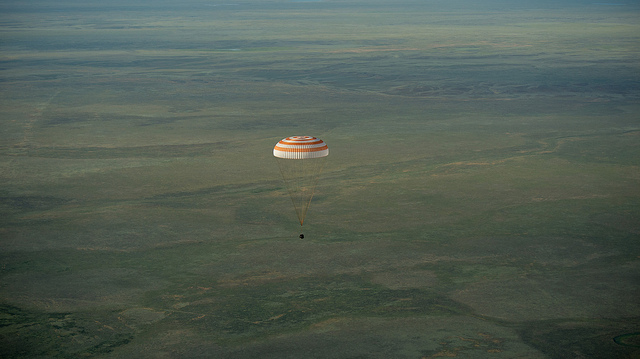
Q: A few more questions about the status of the vehicle. Have you turned on the contract for IDA-3 (International Docking Adapter-3) with Boeing (to replace the docking adapter lost on the SpaceX failure)?
A: “We had it at the last board (meeting). Yes, that just got the approval as a contract option. So yeah, we turned them on to be able to work on IDA-3.
Q: When does that fly?
A: “We’ve identified SpaceX-14. You could probably guess that SpaceX-14 is in 2017 somewhere. If we fly SpaceX-9 in the spring, it’ll have the (second) IDA on it, so with that IDA and the C2V2 (communications antenna) system, we can begin doing dockings. We’re going to put IDA-2 on PMA-2 (Pressurized Mating Adapter-2), so it’ll become the Node 2 (Harmony module) forward docking port. We’ll be able to support the near-term dockings that are required.
“The extra docking port gives us redundancy and also gives us the ability to do direct crew handover, but we would certainly have the next port up there before commercial crew got flying. If we got funded and they started flying in late ’17 or early ’18, we’d have the extra IDA up by then to support direct handover. If (IDA-3) got pushed back for some reason, we could certainly do it with one. We’d just have to do in-direct handovers which we know how to do.”
Q: Boeing has parts for IDA-3?
A: “That’s largely true. There are some components they’ve got to procure, but the long-lead items were procured, so in that respect that’s done. They gave us a pretty long schedule that we’re now working to push back in to see if that can meet this mid-2017 launch date (on SpaceX-14).
“So in some respects, it’ll make sense from a numbering standpoint because IDA-2 will be on Node 2, and IDA-3 will be on PMA-3, if you’re looking for the silver lining.”
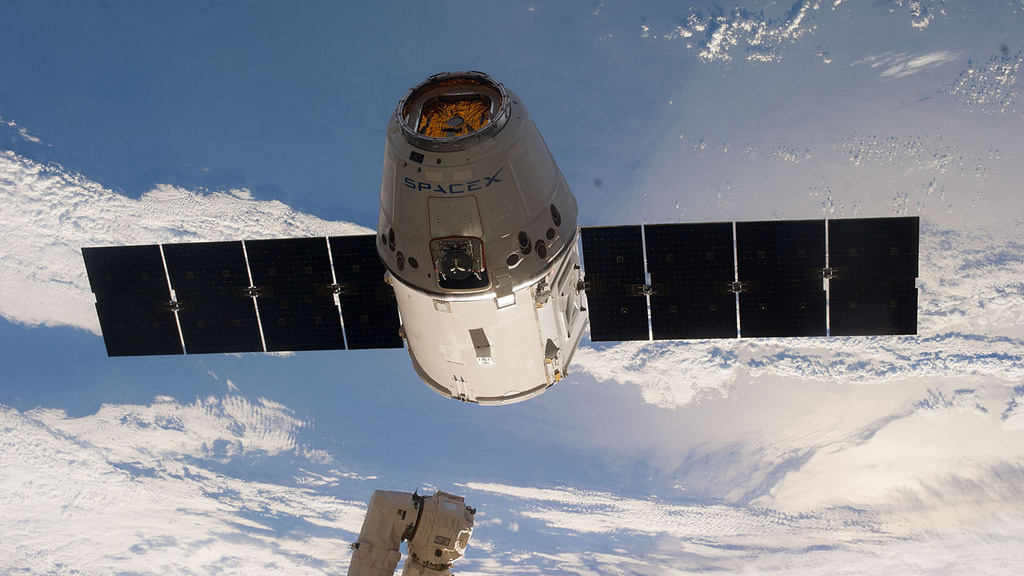
Q: How are you doing with downmass? Do you require someone else to provide downmass besides SpaceX?
A: “The Dragon capability is quite sufficient for our needs. You fly three or four Dragons (per year) with 1,500 kilograms (3,300 pounds) of capability for return, and something like six powered mid-deck lockers, that’s quite a bit of capacity to take care of our needs.”
Q: How are the spacesuits doing? I know you lost one on SpaceX and you’ve been working a water pump issue. Are they ready for EVAs?
A: “We lost one of them. We were going to bring home EMU 3011. We installed a fan set pump inside 3011, and it’s been checked out. Meanwhile, we have this water pump rotor issue. This is the water pump that pumps water through the coolant system. Everything else works. The team has gone off and done quite a bit of work to determine root cause. We think we understand it, and we think this version of the rotor will be less susceptible, but the suits that we have do have quite a bit of run time on them, so we think their rotors are OK.
“The failure mode associated with this, there’s no alarm that goes off with the with pumps. You eventually figure out that you’re hot, and you switch the coolant loop switch, and you don’t cool down. That’s when you figure out it’s not working. In that case, you just slow down and get your metabolic rate back down. There’s still cool air blowing in through the helmet over your face. Quite a few crews spend quite a bit of time in bypass (mode), so they don’t use the cooling loop much, through the LCVGs, the liquid cooling garments. We’ll test it when we go outside right as we go out the airlock. We’ll check it to confirm it works as we start.
“If we get to this point during an EVA you just stop, sit still, slow down and cool down. You may start putting stuff away slowly, you just do kind of an orderly slow clean-up and start working your way back to the airlock. When the sun sets, you’re fine really. When the sun’s up, if you have a high metabolic rate, then you might be uncomfortable. It’s not life-threatening, so there’s no rush to come in. Now that we’ve done all these assessments, we’re planning for some EVAs this fall. We’re talking about doing two pairs of EVAs possibly.”
Q: So those EVAs are to prepare for commercial crew dockings?
A: “The main things we’ve talked about is we’ve got the SSRMS LEE (robotic arm latching end effector) that we need to lube. We’ve got cameras we need to fix. We’ve got PMAs (docking ports) to disconnect, move with the arm and then reconnect. Of course, we can’t do all that in one EVA. There’s some configuration work that we need to do to be able do that. Also, when we had our (ammonia) cooling pump issue, we deployed our radiator on P6 — the trailing radiator — and we really need to get that thing put back away because when it’s sitting out there, it’s a higher risk with regard to MMOD (orbital debris) impacts. Everything is cooling fine now, so we’d like to put it away so we’re less susceptible to impacts. That’s one of the big things on our list for things to go do, retracting that array, which takes some time. We have a number of things we need to take care of, including possibly getting the PMA-3 work done if we can get that done with everything else we’ve got to take care of.”
Email the author.
Follow Stephen Clark on Twitter: @StephenClark1.

